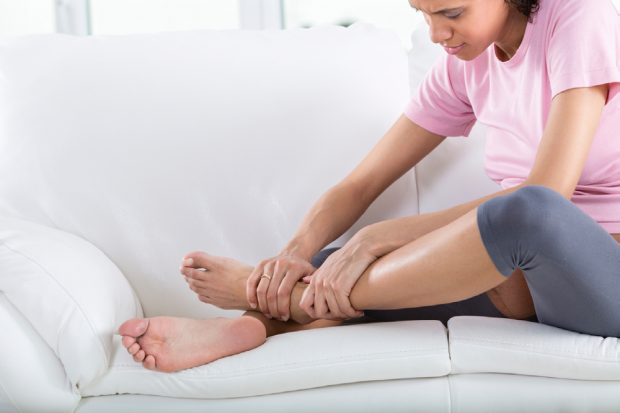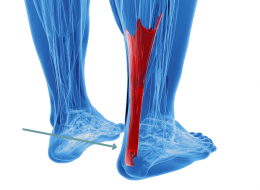Pain Relief Achilles Tendon Pain: Find Out If Yours Is Tendonitis Or Tendonosis
If you’re experiencing aching, tenderness and discomfort in the back of your heel, ankle or lower calf area, you may be suffering from Achilles tendonitis or Achilles tendonosis. We’ll help you determine which condition may be causing the pain and what you can do about it.
Injuries to the Achilles tendon, or the band of tissue that connects the calf muscle to the heel bone, are very common occurrences that can result in either Achilles tednonitis or Achilles tendonosis. The longest tendon in your body, the Achilles tendon allows you to point your toes and extend your foot for walking and running. Because it is used so frequently, it is vulnerable to both of the above conditions — injuries that can cause pain, aching, stiffness, tenderness and discomfort in the heel, foot, ankle and lower calf area.
The Difference Between Achilles Tendonitis and Achilles Tendonosis
The two most common conditions that affect the Achilles tendon, sometimes called the heel cord, are Achilles tendonitis and Achilles tendonosis.
Achilles tendonitis (sometimes spelled tendinitis) is an inflammation of the Achilles tendon, and it generally occurs when the tendon has been overused or has experienced a sudden increase of activity. There are two types of Achilles tendonitis: noninsertional, which is when the fibers in the middle portion of the tendon have begun to break down with tiny tears, and insertional, which is when fibers in the lower portion of the tendon have begun to break down with tiny tears.
If either type of Achilles tendonitis is not dealt with right away, it could progress into Achilles tendonosis, which is when the swollen and inflamed Achilles tendon begins to degenerate, lose its organized structure, develop microscopic tears and possibly rupture. In essence, Achilles tendonosis is an advanced stage of Achilles tendinosis.
Symptoms: What Does an Achilles Tendon Injury Feel Like?
As described above, injuries to the Achilles tendon cause pain, aching, stiffness, tenderness and discomfort in the ankle, heel (the calcaneus bone), foot, and calf (which consists of the gastrocnemius muscle and soleus muscle).
Achilles tendonitis symptoms include:
- Mild pain in the area right above your heel that increases when stretching or standing on your toes
- Swelling
- Stiffness
- Difficulty flexing
Achilles tendonosis symptoms include:
- Abrupt and severe pain in the area right above your heel
- A snapping or popping noise that occurs in the tendon area
- Swelling
- Extreme stiffness
- Enlargement of the tendon that eventually leads to nodules where the tissue is damaged
Generally, Achilles tendon pain is at its worst in the morning and following physical activity.
Causes of Achilles Tendon Conditions and Pain
The most common causes of Achilles tendonitis and Achilles tendonosis are overuse of the Achilles tendon and a sudden increase of physical activity. The ongoing stress from both occurrences creates tiny tears in the tendon fibers that the body is unable to repair during the continued stress. This can alter the structure of the tendon, which then results in prolonged pain.
Examples of common activities that can lead to Achilles tendon pain include:
- Engaging in too much physical activity
- Increasing physical activity too quickly
- Wearing high heels, which can increase stress on the tendon
- Not stretching your muscles and tendons before physical activity
In addition, conditions like over pronation (a flattening of the arch of the foot), bone spurs and gout can lead to Achilles tendon problems, as there are greater demands placed on the tendon while engaging in physical activity — even something as simple as walking.
Common Treatments for Achilles Tendon Injuries
Only a doctor can correctly diagnose Achilles tendon problems. Typical methods include visual examination of the range of motion in the heel, ankle and lower calf area to determine the extent of the damage and more extensive examination via x-rays and other imaging methods.
Depending on the degree of damage to the Achilles tendon, your health care provider may recommend a number of treatment options, including:
- A cast or walking boot to reduce demands on the tendon and promote healing
- Oral medications to reduce pain and swelling
- Applying ice to the affected area to reduce pain and swelling
- A night splint to help stabilize and stretch the tendon
- Physical therapy and/or exercises to strengthen and heal the affected area
- Rest and a decrease in your normal amount of physical activity
- Supportive shoes and orthotics
- Extracorporeal shockwave therapy (ESWT)
It generally takes two to three months for Achilles tendon injuries to heal. In rare cases, your doctor may recommend surgery if and when the above methods fail to repair the Achilles tendon to a normal working condition. There are three common surgical procedures for Achilles injuries that do not improve within six months of non-surgical treatments. They include:
- Gastrocnemius recession, which is a lengthening of the gastrocnemius muscles in the calf. This increases the range of motion in the ankle and decreases muscle tightening.
- Débridement and repair, which is the removal of damaged tissue followed by sutures or stitches to complete the repair.
- Débridement with tendon transfer, which is the removal of damaged tissue and replacement of the tendon with a tendon from the big toe. This is a rare operation that only occurs when more than 50% of the tendon is damaged. It generally does not affect movement in the big toe, contrary to popular belief.
How to Prevent Achilles Tendonitis
The simplest ways you can prevent Achilles tendon injuries include:
- Properly stretch your feet and leg muscles before and after exercise
- Gradually increase physical activity at a level comfortable for your body
- Wear properly fitted shoes appropriate for the activity you’re engaging in
- Try not to overwork your body during exercise, sports and other physically demanding activities
Notice concerning medical entries:
Articles having medical content shall serve exclusively for the purpose of general information. Such articles are not suitable for any (self-) diagnosis and treatment of individual illnesses and medical indications. In particular, they cannot substitute for the examination, advice, or treatment by a licensed physician or pharmacist. No replies to any individual questions shall be effected through the articles.







